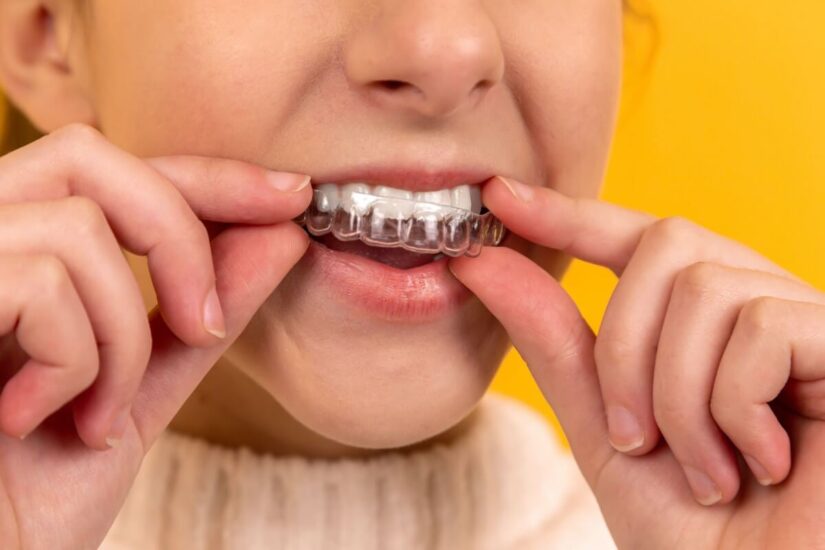Can Invisalign Replace Braces?
January 15, 2024

When your teeth are not aligned, you may need orthodontic treatment to fix the problem. Typically, this is done using metal braces that straighten your teeth over time. However, traditional braces are not your only option anymore. Invisalign aligners provide similar treatment via clear retainers that straighten your teeth without the look of metal braces.
So can Invisalign replace braces? Key differences between Invisalign treatments and braces can impact which option is most effective for you. If you are unsure which is right for you, reach out to a dentist to learn more about your options.
Understanding Invisalign
Invisalign is a great option for straightening teeth that need simple straightening treatment. Unlike traditional metal braces treatment, Invisalign works without the semi-permanent metal brackets of traditional braces. Instead, they are a series of clear retainers that you wear all the time except when eating and brushing your teeth.
If you are undergoing orthodontic treatment but do not want visible braces, Invisalign may be the right option for you. This is a common choice for adults who do not want to wear braces. You may even have the opportunity to switch from braces to Invisalign if your treatment is simple enough.
Traditional Braces
If Invisalign clear aligners are not for you or are not within your budget, traditional braces may be best for you. Wearing braces is one of the most effective ways to straighten teeth and deal with complex orthodontic issues. Braces are also potentially less visible if you choose ceramic braces or lingual braces.
Ceramic braces are made of a tooth-colored material, rather than plain metal. This can help reduce the visibility of the braces, and the composite material may cause less gum irritation.
Lingual braces offer an even higher level of discretion. Rather than being affixed to the front of each other, lingual braces are attached to the backs of your teeth. This reduces visibility to nothing, meaning many people will never know you have braces in the first place.
However, one of the downsides to wearing braces is that you will need to pay extra attention to your oral hygiene. Cleaning your braces is vital because failure to prevent staining can leave marks on your teeth when the brackets are removed.
Can Invisalign Replace Braces?
In some ways, Invisalign may be the best way to protect your oral health and get the orthodontic treatment you need. While Invisalign costs can be high, they may still be lower than the cost of braces. That can make clear aligners a great option for those who struggle to afford traditional braces.
However, this is not the right answer for all patients. While Invisalign can help straighten crooked teeth, it cannot repair more complex issues. If you have extreme irregularities, or if you need correction to your bite or jaw, Invisalign may not be the right option for you.
The difference in the visual look of braces versus Invisalign may also not be as stark if you choose clear braces. The key to choosing the right treatment options for you or your family is to speak to an orthodontist to make an informed decision about your oral health.
Invisalign Is Less Painful
When you choose an Invisalign system to get straight teeth, you may notice a difference in pain levels. Aligning teeth requires moving the teeth into a different position, which can cause some pain. This is true for those with braces, especially after an adjustment. Many people face moderate pain that can make chewing difficult in the days following an adjustment.
The good news is that clear plastic aligners move your teeth into place without as much pain. While it may take more orthodontist visits to complete your treatment, your teeth will be moved more slowly, so that you will not have as much pain. Talk to a dental professional about your options and the pain levels you may experience.
Braces May Be Required for Complex Orthodontic Cases
When you have a serious dental condition, it may be detrimental to your treatment plan to switch from braces. This is important in more severe cases, where a tooth may be severely out of place or when braces would lead to better oral health outcomes.
For example, you may need rubber bands to repair issues with your jaw. This may not be an option with Invisalign, which may be unable to give you the beautiful smile that you deserve. Because these bands are specifically meant to loop around the metal brackets of your braces, you may be unable to rely on Invisalign for these issues.
For those who only need an adjustment to crooked teeth, Invisalign can give them the smile they want. Because your needs can vary, your best option is to speak with a dentist or orthodontist about your current treatment, so you have a better idea of what your teeth need and what option is best for you.
Braces May Offer Faster Treatment
Invisalign works by slowly shifting your teeth with aligners over time. You will need to regularly switch aligners to keep up your progress, but this process also helps prevent pain as your teeth are adjusted. While braces may be more painful, you may see results in a much shorter time frame.
While you may need to worry more about regular brushing and sticky foods when you have a metal mouth, you may need braces for a far shorter time than you would need custom-made aligners. Because braces move teeth faster, your treatment time may be reduced, leaving you with your teeth in the desired position more quickly.
Switching from Braces to Invisalign
While Invisalign might not replace braces completely, they can be a better option than getting braces for your teeth. You may not have a severe orthodontic problem, so their invisible appearance may appeal to you more.
When looking into this treatment option, our dental team can offer you the steps to switch from braces to Invisalign, your payment options, and your treatment plans to get the most incredible smile possible.
Start with an Evaluation
If the discreet appearance of Invisalign aligners appeals to you, your first step is to evaluate your situation with an orthodontist. Starting with in-person appointments, we can evaluate how far your teeth are from the correct position, what treatment you need, and what your monthly payment plans will be if you choose to change treatments.
Once your office visits have settled the final cost of your treatment and your next steps, you can then begin preparing for Invisalign treatment.
Get Your Braces Removed
The first step to getting your Invisalign treatment started is to first remove your braces. This may be a big benefit to those who are self-conscious about wearing braces and it can make eating meals easier.
Removing your braces will require an extra office visit to your orthodontist. Many patients may take an hour or more for x-rays, evaluations, and the removal of the brackets. Fortunately, they can also breathe easier knowing that they can now eat certain foods.
Once your braces are removed, you will need to schedule your Invisalign appointment as soon as possible. Your teeth will need structure to prevent movement and misalignment, so acting as soon as possible can help avoid issues.
Set Up Your Invisalign Treatment with Your Provider
Once you have had your braces removed, it will then be time to begin your Invisalign treatment. One of the first steps is to measure your teeth for the aligners. This begins by taking X-rays and molds of your teeth so that they can make a retainer that fits your needs. This process can take some time, as the Invisalign professionals will need to ensure your aligners fit snugly on your teeth without causing issues with your jaw.
Once the aligners are completed, you will receive your first set. These will need to be worn in between eating, brushing, and flossing. Failure to remove your aligner at these times can lead to an increased risk of damaging the aligners.
Talk to Us About Making the Switch
When you need braces, you may feel self conscious about the way they look, find frustration that you cannot eat certain foods like hard candy, or may simply prefer the discreet look of clear aligners. While Invisalign is not a one-size-fits-all solution, it is a potential option for many people seeking a chance in their orthodontic care.
If you are thinking about making the switch to Invisalign, our dental office in Pineville is here to help you make the right decision for your teeth. Our dental professionals handle complex cases and want you to have a beautiful smile and the best treatment options for the specific needs of your teeth.
When you are ready to speak with someone at Park Crossing Dentistry, reach out to our team to learn more about your options. We can be reached to schedule an appointment by calling or filling out the online contact form on our contact page.
